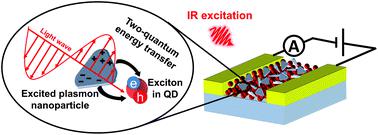Our official English website, www.x-mol.net, welcomes your feedback! (Note: you will need to create a separate account there.)
Plasmon–exciton interaction strongly increases the efficiency of a quantum dot-based near-infrared photodetector operating in the two-photon absorption mode under normal conditions
Nanoscale ( IF 6.7 ) Pub Date : 2021-11-15 , DOI: 10.1039/d1nr06229h Victor Krivenkov 1, 2 , Pavel Samokhvalov 1 , Ivan S Vasil'evskii 3 , Nikolai I Kargin 3 , Igor Nabiev 1, 4, 5
Nanoscale ( IF 6.7 ) Pub Date : 2021-11-15 , DOI: 10.1039/d1nr06229h Victor Krivenkov 1, 2 , Pavel Samokhvalov 1 , Ivan S Vasil'evskii 3 , Nikolai I Kargin 3 , Igor Nabiev 1, 4, 5
Affiliation

|
Semiconductor quantum dots (QDs) are known for their high two-photon absorption (TPA) capacity. This allows them to efficiently absorb infrared photons with energies lower than the bandgap energy. Moreover, TPA in QDs can be further enhanced by the interaction of excitons of the QDs with plasmons of a metal nanoparticle. We fabricated nonlinear plasmon–exciton photodetectors based on QDs and silver nanoplates (SNPs) to demonstrate the optoelectronic application of these effects. A thin layer of CdSe QDs was used as a source of charge carriers for a photoresistor-type photodetector. SNPs with near-infrared plasmon modes were introduced into the layer of QDs to increase the light absorption efficiency. Under near-infrared irradiation, the power of the dependence of the photocurrent on the excitation intensity was twice the power of the corresponding dependence under one-photon excitation with visible light. This proved that the new photodetector efficiently operated under two-photon excitation. Although the SNP light absorption was linear, energy was transferred from plasmons to excitons in the two-quantum mode, which led to a nonlinear dependence. Moreover, we found that the photocurrent from the designed photodetector containing the QD–SNP composite was an order of magnitude higher than that from a photodetector containing QDs alone. This can be explained by the plasmon-induced increase in the TPA efficiency.
中文翻译:

等离子激子相互作用极大地提高了在正常条件下以双光子吸收模式运行的基于量子点的近红外光电探测器的效率
半导体量子点 (QD) 以其高双光子吸收 (TPA) 容量而闻名。这使它们能够有效地吸收能量低于带隙能量的红外光子。此外,量子点中的 TPA 可以通过量子点的激子与金属纳米粒子的等离子体的相互作用得到进一步增强。我们制造了基于 QD 和银纳米片 (SNP) 的非线性等离子体激子光电探测器,以证明这些效应的光电应用。一层薄薄的 CdSe QD 被用作光敏电阻型光电探测器的电荷载流子源。将具有近红外等离子体模式的 SNP 引入 QD 层以提高光吸收效率。在近红外照射下,光电流对激发强度的依赖性的功率是可见光单光子激发下相应依赖性功率的两倍。这证明新的光电探测器在双光子激发下有效运行。尽管 SNP 光吸收是线性的,但能量在双量子模式下从等离子体转移到激子,这导致了非线性依赖性。此外,我们发现包含 QD-SNP 复合材料的设计光电探测器的光电流比仅包含 QD 的光电探测器的光电流高一个数量级。这可以通过等离子体诱导的 TPA 效率增加来解释。尽管 SNP 光吸收是线性的,但能量在双量子模式下从等离子体转移到激子,这导致了非线性依赖性。此外,我们发现包含 QD-SNP 复合材料的设计光电探测器的光电流比仅包含 QD 的光电探测器的光电流高一个数量级。这可以通过等离子体诱导的 TPA 效率增加来解释。尽管 SNP 光吸收是线性的,但能量在双量子模式下从等离子体转移到激子,这导致了非线性依赖性。此外,我们发现包含 QD-SNP 复合材料的设计光电探测器的光电流比仅包含 QD 的光电探测器的光电流高一个数量级。这可以通过等离子体诱导的 TPA 效率增加来解释。
更新日期:2021-11-23
中文翻译:

等离子激子相互作用极大地提高了在正常条件下以双光子吸收模式运行的基于量子点的近红外光电探测器的效率
半导体量子点 (QD) 以其高双光子吸收 (TPA) 容量而闻名。这使它们能够有效地吸收能量低于带隙能量的红外光子。此外,量子点中的 TPA 可以通过量子点的激子与金属纳米粒子的等离子体的相互作用得到进一步增强。我们制造了基于 QD 和银纳米片 (SNP) 的非线性等离子体激子光电探测器,以证明这些效应的光电应用。一层薄薄的 CdSe QD 被用作光敏电阻型光电探测器的电荷载流子源。将具有近红外等离子体模式的 SNP 引入 QD 层以提高光吸收效率。在近红外照射下,光电流对激发强度的依赖性的功率是可见光单光子激发下相应依赖性功率的两倍。这证明新的光电探测器在双光子激发下有效运行。尽管 SNP 光吸收是线性的,但能量在双量子模式下从等离子体转移到激子,这导致了非线性依赖性。此外,我们发现包含 QD-SNP 复合材料的设计光电探测器的光电流比仅包含 QD 的光电探测器的光电流高一个数量级。这可以通过等离子体诱导的 TPA 效率增加来解释。尽管 SNP 光吸收是线性的,但能量在双量子模式下从等离子体转移到激子,这导致了非线性依赖性。此外,我们发现包含 QD-SNP 复合材料的设计光电探测器的光电流比仅包含 QD 的光电探测器的光电流高一个数量级。这可以通过等离子体诱导的 TPA 效率增加来解释。尽管 SNP 光吸收是线性的,但能量在双量子模式下从等离子体转移到激子,这导致了非线性依赖性。此外,我们发现包含 QD-SNP 复合材料的设计光电探测器的光电流比仅包含 QD 的光电探测器的光电流高一个数量级。这可以通过等离子体诱导的 TPA 效率增加来解释。



























 京公网安备 11010802027423号
京公网安备 11010802027423号